A "monetarist" perspective on current equity markets
Global economic growth was depressed over the past 18 months by the disruptive effects of the crash in oil prices and successive slowdowns in China and the US. These drags are fading, while global money and credit trends remain solid. The combination of recovering economic activity with plentiful liquidity argues for a positive bias towards equity markets but there are risks stemming from poor productivity performance, an associated rise in “core” inflation and possible further policy missteps.
Economists expected the 2014-15 oil price collapse to boost global growth as increased disposable income and spending of energy consumers offset cut-backs by producers. This neglected the scale of overinvestment in energy extraction during the period of high prices and the consequent potential for a capex bust. US consumers, meanwhile, saved much of the windfall from lower energy bills, perhaps reflecting lingering post-crisis caution and an expectation of higher interest rates.
Energy capex cuts are probably nearing an end, while the US personal saving ratio may be at or close to a peak. The oil market is returning to balance, suggesting a stabilisation or recovery of prices. Following a sharp increase in 2014-15 that triggered the price collapse, global oil supply growth is slowing and may soon converge with rising demand expansion – see first chart.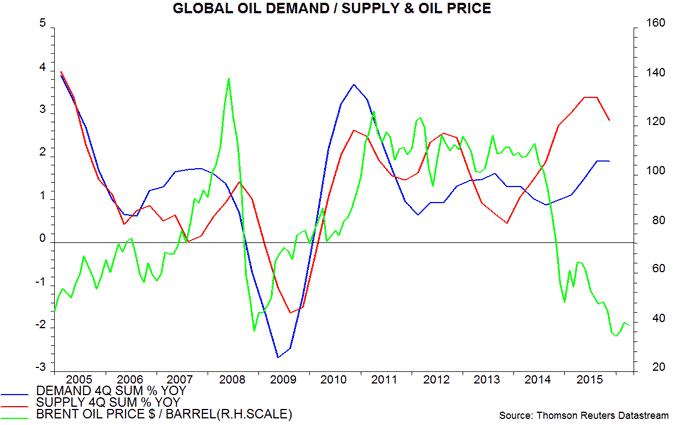
China’s economic slowdown was a major drag on global growth in 2015. It had been predicted by monetary trends: the six-month rate of change of real (i.e. inflation-adjusted) narrow* money, as measured by “true” M1, turned negative at the end of 2014 – second chart. Following policy easing during the first half of 2015, however, real money growth rebounded strongly, suggesting an economic recovery in 2016. This appears to be playing out, with the housing market strengthening, profits recovering and business confidence rising.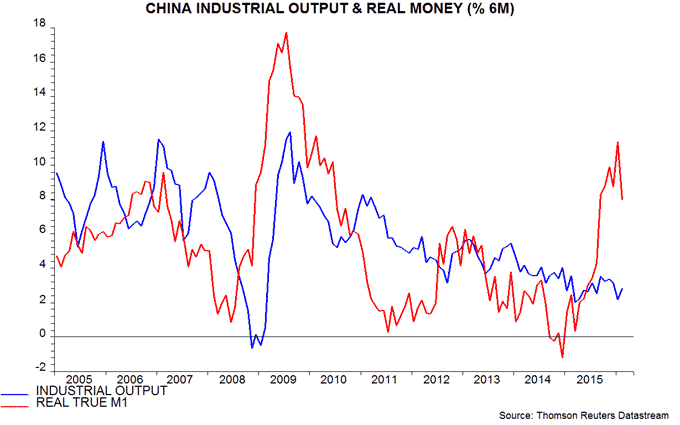
The Chinese slowdown was followed by a loss of US economic momentum in late 2015 and early 2016. This had also been foreshadowed by monetary trends, with real narrow money slowing sharply between February and October 2015 – third chart. Real money growth remains modest but has recovered in early 2016, consistent with the economy regaining some momentum during the second half.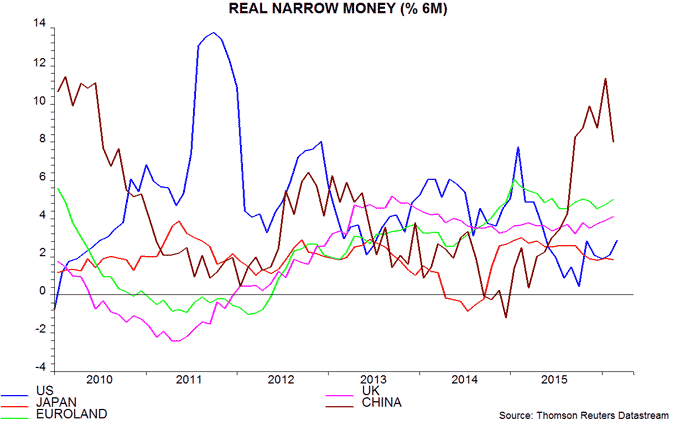
The US economic slowdown has pushed back interest rate rises, relieved upward pressure on the US dollar and contributed to a rally in commodity prices – in line with the central scenario proposed in our previous commentary. Worries about higher US interest rates may remain in abeyance during the second quarter as recent low GDP growth feeds through to softer labour market data. Recovering monetary expansion suggests that upward pressure on rates will return later in 2016, however.
European economic growth has been stable and respectable, questioning downbeat commentary on the region. Eurozone GDP rose by 1.6% in the year to the fourth quarter of 2015, with domestic demand up by 2.2% – the fastest annual growth since 2007. This performance should be assessed against “potential” economic expansion estimated by the EU Commission, IMF and OECD at only 1.0-1.2%. Above-potential growth has been reflected in a steady decline in unemployment.
UK economic solidity has also received insufficient recognition. GDP growth in the fourth quarter was the highest in the G7 and the indications for the first quarter are positive. Real narrow money growth in the Eurozone and UK remains stable and stronger than in the US and Japan, suggesting upside risk to consensus GDP forecasts.
Our “global” real money and bank lending growth measures, covering the G7 developed economies and seven large emerging economies (the “E7”), have remained range-bound at historically-respectable rates – fourth chart. Real money growth continues to run well above economic expansion, a condition normally associated with rising asset prices. The resilience, in aggregate, of equity, bond and property markets despite recent economic difficulties is consistent with a supportive liquidity backdrop.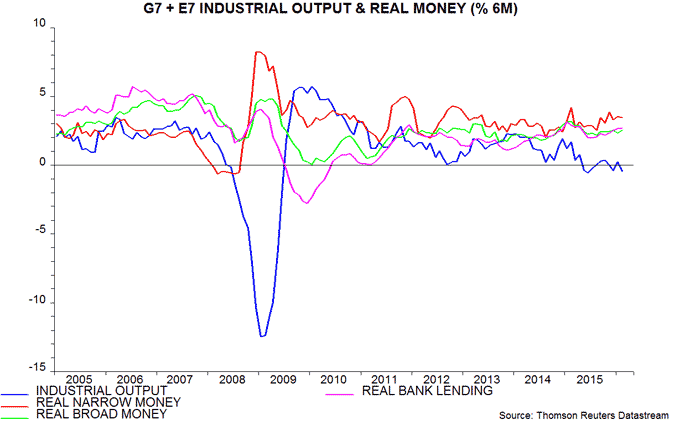
The recovery in equity markets later in the first quarter may partly discount a near-term firming of global economic growth and an extension of the US interest rate pause. The combination, however, of plentiful liquidity with positive economic news from China / Europe and a cooler US labour market over the spring / summer may allow the rally to extend.
The assessment here is cautiously rather than fully optimistic, for several reasons. First, global productivity trends remain dismal. Productivity stagnation has supported growth of employment and consumer spending but at the expense of rising unit labour costs and a squeeze on profit margins. Labour markets, moreover, may now have tightened sufficiently to trigger an acceleration of wages.
Secondly, and relatedly, G7 “core” inflation is firming, threatening a sharp rise in headline rates later in 2016 as favourable energy and food price effects unwind. The annual increase in G7 consumer prices excluding food and energy was 1.6% in February, a four-year high – fifth chart. An inflation snap-back could raise concerns that G7 monetary policies are excessively loose, leading to a disruptive rise in bond yields.
Rising inflation, it should be emphasised, is an issue for developed rather than emerging economies. E7 core pressures are moderating in response to weak activity and currency stabilisation, opening the door to monetary policy easing – sixth chart. 
A third concern is that ECB and Bank of Japan experimentation with negative interest rates will have a net contractionary impact, for example by damaging banks’ profitability and capacity to expand or prompting households to save more to achieve asset growth targets. Monetary trends have weakened in Denmark and Switzerland, where rates first became significantly negative. As noted, Eurozone narrow money growth is strong but the numbers have yet to reflect the full impact of December / March rate cuts.
Current real narrow money trends argue for a bias to overweight the Eurozone and the UK while underweighting Japan and the US in a developed markets equity portfolio – second chart. UK relative equity market performance has been depressed by a rise in the risk premium on sterling assets due to the forthcoming June “Brexit” referendum on the country’s EU membership. A rebound is likely in the event of a “remain” decision; “exit” would trigger wider market turbulence, probably involving generalised European underperformance.
In other developed markets, real narrow money is growing respectably in Canada and Sweden but has slowed sharply in Australia and is contracting in Switzerland, suggesting underweighting Swiss equities.
The outperformance of emerging equity markets during the first quarter followed a cross-over of six-month real narrow money growth in the E7 above the G7 level in late 2015 – seventh chart; as noted in the previous commentary, the sign of the E7 / G7 gap has had a positive association with the sign of emerging market relative returns historically. The real money growth gap remains favourable for emerging equities, while a Chinese economic recovery, lower E7 core inflation and a delayed rise in US interest rates may also be supportive.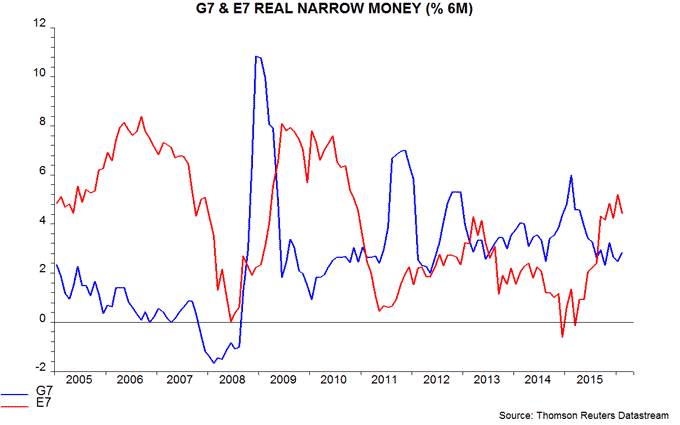
*Narrow money = currency in circulation plus demand deposits and close substitutes. Broad money = narrow money plus time deposits, notice accounts, repos and bank securities. Precise definitions vary by country. Narrow money has been more reliable than broad money for forecasting purposes historically and is consequently emphasised in the analysis here.

Reader Comments